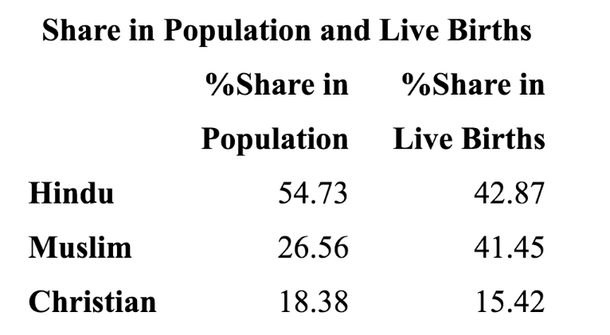Politics
Why Committee On Population Growth And Demographic Changes Will Have Its Task Cut Out
Abhishek Kumar
Feb 02, 2024, 01:43 PM | Updated 02:12 PM IST
Save & read from anywhere!
Bookmark stories for easy access on any device or the Swarajya app.


“The Government will form a high-powered committee for an extensive consideration of the challenges arising from fast population growth and demographic changes. The committee will be mandated to make recommendations for addressing these challenges comprehensively in relation to the goal of ‘Viksit Bharat’,” Finance Minister Nirmala Sitharaman said yesterday (1 February) in Parliament.
In her interim budget 2024, Sitharaman thus proposed a mechanism to tackle what the government thinks is the dual challenge of population growth and demographic changes.
A closer look at numbers however reveals that demographic changes might be the only challenge worth focussing on.
Here's why:
Population Growth Slowing Down Anyway
According to National Family Health Survey (NFHS 2019-21), India’s Total Fertility Rate (number of children a woman gives birth to) has declined to 2.0. It is in fact below the replacement-fertility level (level at which population replaces itself) of 2.1.
In rural areas, it is at 2.1, while in urban areas, it is at 1.6, considerably below the replacement levels.
With more push on pro-women policies and laws and awareness among the people, the population side of the problem should not require extra efforts to deal with.
Demographic Changes
The are two ways to look at the demographic part of the issue — age and religion.
Age-Related Changes
According to latest data from World Population Prospects, India’s average age is 28.2 years. In fact, among major economies, India’s median age is lowest, which provides it an edge in economic competitiveness.
It is the low median age on which India is looking to take its manufacturing journey forward, especially at a time when China and other east Asian powerhouses are either ageing, or are seeing a steep decline in population, or both.
Hence, even in demography, age is not a problem.
Religious Demography
The last available Census figures indicate an acceleration in shift towards demographic change with respect to religious communities in India.
According the 2011 Census, the proportion of Hindu population to total population had witnessed a decrease of 0.7 per cent between 2001 and 2011. The corresponding figure for Sikh population was 0.2 per cent points.
Simultaneously, Muslims’ share in total population had witnessed an uptick of 0.8 per cent. The change was driven by 24.6 per cent growth rate of Muslim population during that period. In the same time-frame, Hindus’ population increased by only 16.8 per cent while, Christians and Sikh population increased by 15.5 and 8.4 per cent only.
Notably, these numbers do not reflect people who have converted out of the Dharmic faiths but do not return themselves as Muslim/Christian to the authorities out of fear of losing out on reservation benefits.
They also do not reflect the rapid scale of change in many regions of India. Eastern India and Kerala are witnessing a faster change of religious demography than other regions.
The below graph, for example, shows the share of communities in live births in Kerala in 2015, taken from this piece by JK Bajaj in Swarajya.

Note also, this quote from the same piece:
According to Census 2011, there are 8.9 children (of age 0-6 years) per hundred of the population among Hindus and 14.4 among Muslims. Thus there are 5.5 extra children among Muslims for every 100 of the population as compared to Hindus. In 2001, the number of children per hundred of the population was 11.91 among Christians, 10.81 among Hindus and 14.99 among Muslims. The gap between Hindus and Muslims then was of 4.2 children per hundred; it has widened to 5.5 in 2011.
It is a similar story on the other end of the country in Assam and West Bengal, as narrated by this graph, again from a JK Bajaj piece for Swarajya:


In the past, whenever members of the ruling party have tried to raise the issue of population growth, opposition has not responded kindly.
Even after announcement of this committee, CPI(M) MP John Brittas seemed suspicious of the Government's intentions.
To be clear, the Finance Minister did not spell out anything more about the brief of the committee on population growth and demographic changes, and neither has the government said anything more on it.
A closer look at the numbers however suggests that between population and demographic changes, the shifts in religious demography is the aspect which requires intervention of both state and society.
Demography, is destiny.
Abhishek is Staff Writer at Swarajya.





